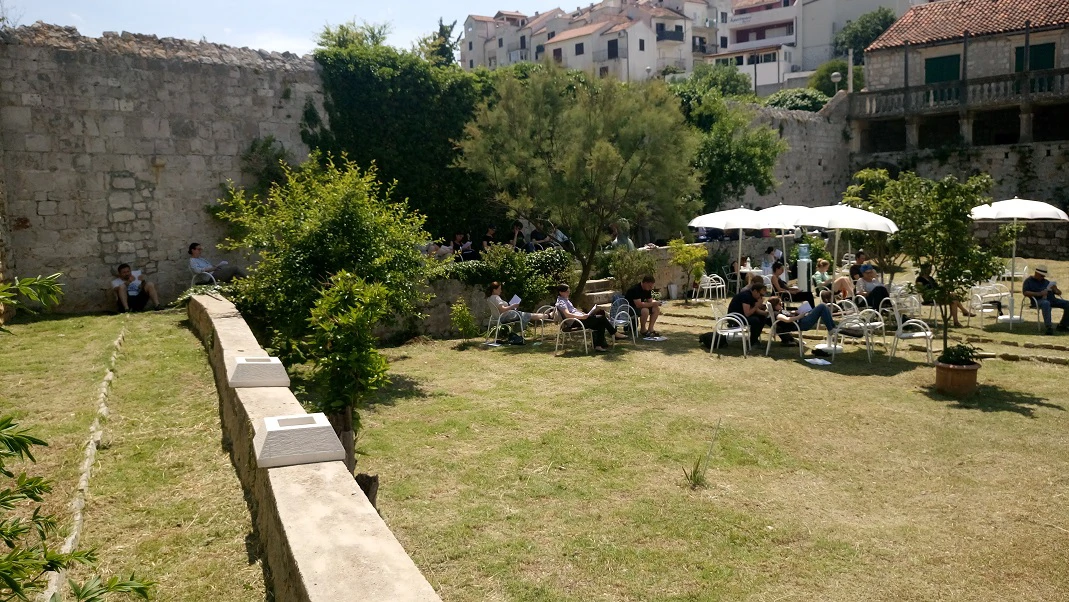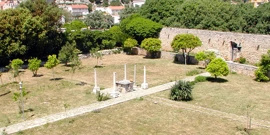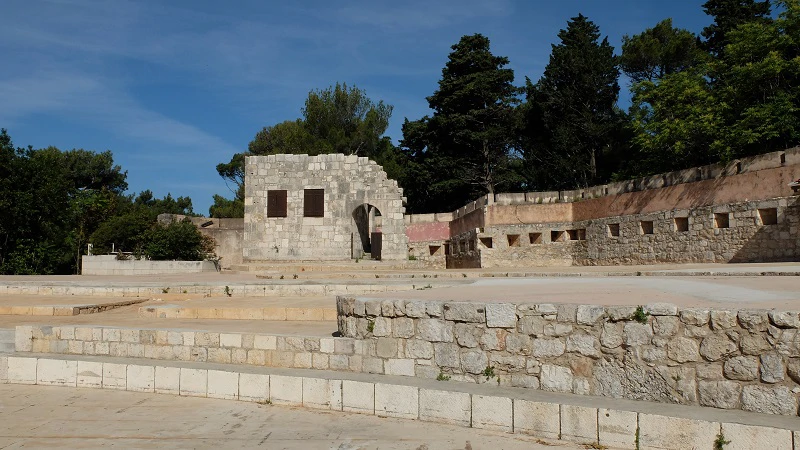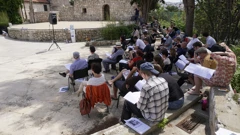The first important characteristic of the Hvar festival are the places in which the festival presentations are held. As it entered authentic historical sites the festival became an ambiental radio festival where the fullness of the experience is enhanced by the links and bond between the sounds and texts, and the atmosphere of the setting in which they are presented.
Listening Locations
28.01.2021.
17:37
Autor: HRA
1. Summer Residence of the Poet Hanibal Lucić
The former summer residence of Hanibal Lucić is the most famous among the suburban summer residences of Hvar. It lies on the edge of a historic path which has connected Hvar with Stari Grad for ages. The fortified residence was built in the mid- 16th century. It includes two houses and a Renaissance garden. The landlord lived in the eastern house, while the servants occupied the western house. The residence now houses the Hvar Heritage Museum and the state archives.
Galerija


2. City Fortress / Fortica
Together with the city walls, the fortress forms an imposing stronghold. Its construction began in 1278, when Hvar was under Venetian rule. Archaeological finds however suggest that fortified constructions may already have existed in earlier times. In 1551, a new fortress was built on the site of the ancient fortification. Twenty years later, during the devastating attack by the Turks in 1571, the local residents found shelter and protection within its walls. The building was severely damaged by an explosion in 1579 after a thunderbolt had struck the gunpowder depot. It was not restored until the early 17 th century under the reign of Prince Pietro Semitecolo. The Baroque bastions were also built during this period. Under Maria Theresa, the Austrians were last to add barracks to the building in 1775- 1776. Today, the fortress also houses a small museum with an amphora collection.
City Fortress / Fortica
Foto: Prix Marulić Team / HRA
3. Velo Grablje
The village of Velo Grablje was founded in the 15th century. It is surrounded by archeological and historical artefacts dating from Prehistory to the New Age.
The Church of St. Vitus is a finely preserved example of the 9th - 12th century Old Croatian architecture, whereas the Parish Church of St. Cosmo and Damian, in its present day form, was built in 1886, on the location of an older, 16th century church. St Cosmo and Damian are the village patron saints, who are celebrated on 26 September with a great traditional festivity.
Today the village is almost abandoned with around 10 permanent habitants, while it used to be a rich and advanced place.
Velo Grablje has an Agricultural Cooperative, established in 1892 as a Rosemary Cooperative, the first on Hvar island, with a tradition of production of lavender and rosemary essential oils, as well as quality olive oil and honey. The village is best known for its lavender, having been the largest producer of lavender oil in Dalmatia in the mid-20th century. Today, the Velo Grablje rural environment is a cultural good of the Republic of Croatia.
Velo Grablje
Foto: HRA / HRA
4. Veneranda - Former Church and Monastery of St. Veneranda
The church was built in 1561 for the needs of Greek Orthodox sailors who were in the service of Venice. On the initiative of the Croatian Bishop, Girolamo Priulija, a Catolic altar was built next to the Orthodox altar in 1685. The church and the monastery were damaged during the Russian bombardment in 1807. The building complex lost its religious purpose when the French turned it into a fortress in 1811. Later, the Austrians also used the walls as fortification. In 1858, the famous scientist Grgur Bučić established one of Croatia’s first weather stations on this site. In the second half of the 20th century, the complex served as an outdoor cinema.
Galerija


5. The Island Galešnik
In the front row of all of the Pakleni islands, at the very entrance of the port of Hvar is Galešnik. From this little island there is the most beautiful view on the town of Hvar. Its name was probably obtained from Galeša Slavogost, a noble who started the revolution against the Venetian authorities in 1310. In the past it had a strategic importance for defense as well as attack on the town. In 1806, Russians placed cannons there and launched an attack on the town. A military-maritime fort was erected in 1831. After a maritime victory over Vis in 1868 the island was demilitarized and used as a quarantine hospital of the Hvar harbour. In 1936, it became a prison, and in the 1960s the buildings on the island became tourist facilities. In 2005, it was remodelled as an Eco-etno island.
Galešnik
Foto: HRA / HRA
6. The Historic Theatre of Hvar
Historic Theatre of Hvar is a monument of national importance for Croatia, and one of the most important of its kind in Europe. It is situated on the first floor of the Renaissance Arsenal – shipyard and galley utility storage from the mid-16th century. As a key object of port facilities, it is located in the center of urban core of the town of Hvar.
Though modest in size, harmonious Renaissance forms make it one of the most beautiful and best preserved in the Mediterranean.
Nowadays preserved interior of the theater, first built in 1803 when the Theatre Association was established (the first of its kind in Europe), was changed and artistically adapted to the year 1900. Stylistically it belongs to the neo-Baroque period and as such is included in the a dozen of preserved Baroque and neo-Baroque theaters in Europe. Theatre Association also ran the program of the theater. In theatrical seasons, which were associated with the time of carnival, many local and foreign theatrical and musical amateur and professional theater companies performed at the Theatre of Hvar.
The Historic Theatre of Hvar
Foto: HRT / HRT
Vijesti HRT-a pratite na svojim pametnim telefonima i tabletima putem aplikacija za iOS i Android. Pratite nas i na društvenim mrežama Facebook, Twitter, Instagram, TikTok i YouTube!
Vezani sadržaj

Autorska prava - HRT © Hrvatska radiotelevizija.
Sva prava pridržana.
hrt.hr nije odgovoran za sadržaje eksternih izvora
